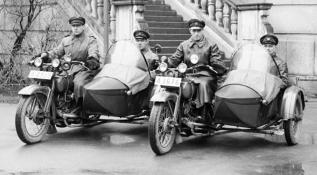

Copyright © Hans Högman 2019-04-01


The Swedish Police System in
former Days
Introduction
There was no police system in Sweden, as we know
the Police of today, until the 18th century. In the
cities, local governments were made responsible for
law and order, by way of a royal decree issued by
King Magnus III in the 13th century. The cities
financed and organized various watchmen, who
patrolled the streets.
It was the City Magistrate that supervised that law
and order was upheld by the appointed law
enforcement agencies in the city. A special
department, the Politikollegiet, was responsible for
this.
The Burgher Watch (Burvakten)
The first police system was the cities’ own watch, the
Burgher Watch. Form the early middle ages, the
cities were surrounded by a city wall. The gates were
guarded and everyone entering the city with
merchandise for sale had to pay a tax. The gates
were closed at night.
In the middle ages, the uphold of law and order
were up to the burghers in the cities. There was no
reimbursement for this. The burghers were also
obliged to defend the city in case war.
Guarding castles and fortresses was the
responsibility of the army.
The responsibilities of the Burgher Watch were:
1.
Maintaining order in the city at nights
2.
Manning the Fire Watch (Brandvakt) which
included patrolling the streets of the city looking
out for fires every night
3.
Act as a defense force in times of war
The patrols were sent out each night when the city
gates were closed.
This was a responsibility and an obligation that each
burgher in the city had to fulfill according to a
schedule. This was of course an unpopular duty.
In daytime the upholding of law and order was
done by the so-called bysvennerna or stadstjänarna.
They were employed by the Mayor and the city
council and were a mixture of street police officers
and bailiffs. They were paid as civil servants.
The City Watch (Stadsvakten)
In Stockholm, a special City Watch was organized in
1594. This was a permanent watch with employed
guards paid by the city, i.e. the burghers. The City
Watch was organized as a military unit with enlisted
men dressed in uniform under the command of a
captain (stadskapten). The Captain was subordinated
the Politikollegiet in the city.
This watch was later renamed to the Stockholm
City Company.
The main duty of the City Watch was to patrol the
streets of Stockholm and guarding the city gates.
They were also to assist in case of a fire by fencing
off the area on fire and to guard personal estate
rescued in the fire.
In 1634 there were 24 watchmen in the City Watch
and in 1659 they numbered 100 guards. The City
Watch’s quarters were at the main square
(Stortorget) in the old town.
The City Watch had the right to arrest anyone
committing crimes of violence or theft. From 1682
they were allowed to open fire when attacked or
interfered in their line of duty.
The watchmen in the City Watch were armed with
swords/rapiers, partisans and muskets.
A partisan was a type of polearm that consisted of a
spearhead mounted on a long shaft, usually
wooden, with protrusions on the sides which aided
in parrying sword thrusts.
The watchmen in the City Watch weren’t very
popular by the townspeople and were nicknamed
Korvar (Sausages) or Korvknektar (Sausage Guards).
The Garrison Guards (Garnisonsvakten)
The City Watch wasn’t enough to uphold law and
order in Stockholm. There were several regiments
garrisoned in Stockholm and they also participated
in maintaining the order of the streets of Stockholm.
These military units were posted in several places in
Stockholm and were patrolling the streets at night.
Each patrol consisted of a corporal and six soldiers.
However, the military patrols and the City Watch
operated independent of each other. The City Watch
had no capacity to investigate criminal cases.
Instead criminal cases were investigated by the Life
Guards, which had a special department for this.
The Fire Watch (Brandvakten)
The Fire Watch as well as the Burgher Watch was
dependent of the burghers’ direct and voluntary
participation. The first fire regulation in Stockholm
was issued in May 1661. The city was then divided
into 4 districts and one and each of these into
several sub districts. In each district a master fireman
was appointed and in each sub district a deputy
fireman. Each house in Stockholm was obliged to
keep a ladder, a fire ax and fire buckets available for
firefighting purposes.
When the fire bell (vårdklockan) rang in the evening
it was no longer allowed to keep a fire going or
candles burning in the houses until the next
morning.
Special fire watchers patrolled the city during nights.
Together with the City Watch they upheld the order
in the city at nights. There were also fire watchers
(tornväktare) posted in many church towers in the
city. The fire watchers sent an alarm if they spotted
a fire by ringing the fire bells. They also used special
signal flags and lanterns to state in which district
there was a fire.
A special Fire Watch Corps was established in 1730
under the command of a fire captain. The fire
watchmen of the corps patrolled the city streets
between 10 in the evening and 6 in the morning.
There were two watchmen in each patrol and the
patrols were assigned a specific district. Each patrol
was equipped with a fire hook mounted on a long
wooden shaft known as brandhake
or väktarsax. Soon these hooks
were equipped with a hoop. The
hoop made it possible to trap
troublemakers and keep them at
an arms-length distance until
reinforcements arrived.
The image to the right shows a fire
watchman with a fire hook.
The hoop in the hook is called
“bygel” in Swedish which became
byling and the fire watchmen were nicknamed byling.
The other end of the shaft had an iron shod and in
an emergency the watchman repeatedly
thrust the shaft to the stone paved street
to warn and awake people in a house on
fire.
The image to the left shows a fire hook
with a hoop. Photo Hans Högman 2011,
Sigtuna town hall.
The fire watchmen worked every two
days. When they weren’t on duty they were entitled
to be engaged in trade in the city.
There were 188 fire watchmen in Stockholm in 1757
and in 1788 fully 200. The uniform consisted in 1760
of a blue coat of broadcloth, blue vest and
blue trousers, black hat and knee-boots.
Above the coat the watchmen wore a long
scarf of wool wrapped around the body
forming a cross tied around the waist.
The image to the right shows a fire
watchman in uniform. Photo Hans
Högman, 2004, Old Linköping.
Together the fire watch, the city watch
and the garrison guards formed system
of law enforcement in the cities which
shows a resemblance with today’s
uniformed police.
The City Watch in the 1700s
A new Captain of the City Watch in Stockholm was
appointed in 1720. He was Nils Hulling, a non-
commissioned officer of the Royal Life Guards.
Hulling gradually changed how police work was
organized in Stockholm, modeled after how law
enforcement was organized in Paris at the time. One
of the first steps he made was to split the City Watch
into two units. The new unit was named the
Separation Watch (Sepatationsvakten) and was
manned with 20 less qualified watchmen of the City
Watch. The task of the Separation Watch was to
keep after vagrants and beggars and to guard the
members of the house of correction when they were
doing street cleaning.
The Separation Watch
was under the
command of a
Corporal and wore
gray uniforms with
blue cuffs. These
watchmen were
armed with sabers
and their nickname
was “paltar”.
The image to the right
show watchmen in the Separation Watch, so-called
“paltar”.
The 1776 Police Regulation
The 1776 Police Regulation was a major change to
the Stockholm police wok. The Governor of
Stockholm, Carl Sparre, was the driving force behind
the new regulation.
A Police Commissioner or Chief of Police
(Polismästare) was appointed and was to report
directly to the Governor. The first Police
Commissioner in Stockholm was Nils Henric
Liljensparre (1738 - 1814). Also, a new office was
established for law enforcement, The Office of the
Police Commissioner or the Royal Police
Department of Stockholm (Kungliga Stockholms
Poliskammare). The Police Commissioner was the
head of the police department. The Stockholm
police department was inaugurated on 22 April 1776
and its jurisdictional area was initially limited to the
central parts of the City of Stockholm.
The Office of the Police Commissioner was partly
financed by the city and partly by the State.
Stockholm was now divided into 33 police districts
and each district was under the command of a
kvarterskommissarie (Police Sergeant?). Under his
command was a huskvartersmästare appointed for
every 10th house in the district.
The reform was considered a success, as it made the
streets of Stockholm safer. However, the system of
the Fire Watch and the City Watch was still kept
intact and administered separately.
The police officers wore no uniforms at this point in
time. Instead they wore a police badge fastened to a
thin chain around their necks.
The City Watch & The Separation Watch
The City Watch wasn’t affected by the 1776 Police
Regulation. However, both their uniforms and
armaments were improved. The watchmen in the
City Watch wore blue coats with white cords and
cuffs and white trousers, black hats and short
leather boots. They were armed with muskets and
bayonets and sabers.
The watchmen in the Separation Watch wore blue
coats and hats with up-folded brims. They were
armed with a short sword (cutlass) and a hazel stick.
They were also equipped with a short piece of rope
to be used as handcuffs.
The Police System in the 1800s
The Police Department
In 1837 a position as Assistant Police Commissioner
was established. A new police regulation was
issued in 1839. The number of sub-police stations
was increased. Each sub-police station was under
the command of a Gevaldiger (police sergeant) with
three police officers (Uppsyningsmän). Each police
district was under the command of a Stadsfiskal.
The custom of wearing police uniforms began at this
time. The uniform consisted of a high hat and a
double-breasted long coat. The police badges were
worn around their necks on a chain. The police
sergeants (Gevaldiger) wore already uniforms at this
time. The police officers were, unlike the watchmen
in the City Watch, not armed with firearms but with
a cudgel. However, in February 1840, the police
officers were being armed with a saber.
The City Watch
A new regulation for the City Watch was issued in
1809 or as it was called now the Stockholm City
Military Company (Stadsmilitärkompaniet). The
number of watchmen was reduced from 168 to 136.
Their uniform consisted now of gray long trousers,
black gaiters and shoes. The trousers was equipped
with white stripes. Headgear was a black hat with
the left brim up-folded. The coat was short with a
white collar and cuffs. The armament was a rifle.
This uniform was used by the watchmen until 1850.
The Separation Watch
The Separation Watch adopted a new uniform in
1816. The watchmen wore a gray long double-
breasted coat, gray trousers and a black hat. The
watchmen were armed with a cutlass and the sword
belt was blue.
A Modern Police Organization
The Stockholm police system was reorganized in
1850. The foundation of the new organization:
1.
All law enforcement agencies was to be organized
within the same office
2.
The number of police officers was to be increased
and be paid a decent salary
3.
The responsibility of the police was to solely focus
on pure police matters
Stockholm was divided into 80 police districts; 16 in
central Stockholm, 24 in the southern parts and 40
in the northern parts. Each district was manned by 4
police officers. A police sergeant district
(Överkonstapeldistrikt) was under the command of a
sergeant (Överkonstapel) and consisted of 4 police
districts. Two sergeant districts formed a “trakt”
under the command of a Kommisarie (Chief
Inspector).
New ranks and titles were introduced in 1850;
Konstapel (Police Constable), Överkonstapel (Police
Sergeant) and Kommissarie (Chief Inspector (UK),
Lieutenant (US). The former ranks Gevaldiger och
Uppsyningsman were abolished.
The police officers wore uniform and their
armament consisted of a short saber or cutlass in a
scabbard and a baton. The old badges were kept as
a police insignia. Each officer wore a viable police
serial number attached to the uniform.
The uniform was dark blue and consisted of a coat
and trousers, vest, overcoat and headgear. The
headgear was a tall cap equipped
with a gold-plated metal badge in
front. The police officers were also
equipped with whistles to be used
to call for reinforcement in case of
an emergency.
The image to the right shows a
19th century police badge,
Stockholm PD. Stockholms
Stadsmuseum. Image: Wikipedia.
At this point in time the judicial and the executive
authorities was still under the same office. The
Överkommisarie (Superintendent (UK), Captain (US))
was both a Police Commander and a Police Judge.
The police judge was a kind of judge conducting
trials in minor cases. Normally the police
department handled the preliminarily investigations
which was handed over to the district court of law
for trial.
Police officers of the Stockholm Police Department
(SPD) also was used for assignments in other places
in Sweden. In that respect the SPD also was a
national police force, like a state police. Later on the
SPD also stationed police officer in different cities
helping the local police with criminal investigations
but also with uniformed police officers upholding
law and order.
The Swedish security service (Säkerhetspolisen) aslo
saw its birth within the SPD.
Police detectives: There was a criminal
investigation department, CID, (Kriminalavdelning)
within the Stockholm Police Department in 1850
consisting of four detectives. In 1856 the
department was under the command of a Police
Lieutenant. In 1866 the department numbered 5
sergeants and 17 detectives and in 1890; 3 Chief
Inspectors (Kommisarie), 5 sergeants and 40
detectives.
In 1864 the Police Department role as a both a
judicial and the executive authority ended. From
now on the Police Department was only to work
with pure police businesses.
In 1870 the police began taking photos of all
detained persons and a portrayal or depiction
system was developed for better and easier
identification of people who was wanted by the
police.
In 1887 a mounted police section was introduced in
the Stockholm PD and was then consisting of 8
police officers. The same year, a riot squad (Piketen)
was organized which stood ready to turnout
between 6:00 in the morning and midnight.
The Stockholm Fire Department
When the new Stockholm Police Department was
established in 1850 the need of the City Watch
diminished. The night watchmen was disbanded
since this now was the responsibility of the police.
However, the fire watchmen was kept.
A new Stockholm City Department was introduced
in 1850, the Stockholm Fire Department,
consisting of voluntary firemen under the command
of two officers and two junior officers.
In 1875 the Stockholm Fire Department was
reorganized into a military type of corps consisting
of professional firemen. Seven fire stations were
opened in Stockholm.
When Stockholm got a professional fire department
the former tower fire watchmen and the remaining
fire watchmen of the City Watch was disbanded in
1885. However, the former watchmen of the City
Watch were organized into a military company with
the purpose to reinforce the upholding of law and
order at night. The company was called the City Hall
Watch (Rådhusvakten). The company consisted of 95
watchmen.
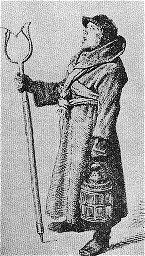


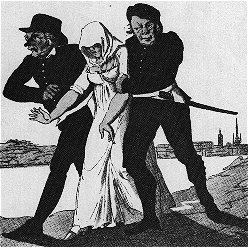
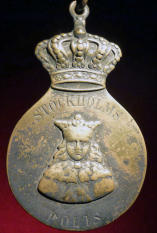
History of the Swedish
Police
The Swedish Police in the 20th
Century
Between 1903 and 1913 a new police headquarters
was being built on Agnegatan, Kungsholmen,
Stockholm. It was a big impressive
building and was at the time
considered an ostentatious
building.
The image to the right shows a
policeman in a uniform from the
early 1900s wearing a spiked
helmet. The long coat is dark blue
and double-breasted with gold-
plated buttons. The uniform could
be different in different cities.
Photo Hans Högman, 2004.
The spiked helmet was abolished in 1926.
The armament was at the beginning of the 20th
century; saber and baton. Pistols were introduced in
1927 and were worn in a holster fasted to the belt.
The saber wasn’t abolished until 1966.
Submachine guns were issued as reinforcement
weapons for close-quarters battles in 1966 and
protective helmets in 1971.
A national forensic center, Statens kriminaltekniska
anstalt, was opened in 1952.
The riot squad, Piketen, was motorized in 1913. The
criminal investigation department also disposed of a
car at this time.
The first police dogs were obtained in 1910. The first
female police officers, or police sisters as they were
called (polissystrar), were employed
in 1908, They were foremost used
to take prostitutes into custody.
The security service, SÄPO,
expanded strongly during WWII.
The first radio patrol cars were in
use in 1935.
The image to the left shows a city
policeman wearing a uniform in the
early 1920s. This uniform was used
until 1926. The photo is shown with
the consent of Catharina
Willebrand.
The image to the right shows an
old police sign that was used in the
city of Mariefred, Södermanland.
The sign reads; Police Station.
Photo Hans Högman, 2007.
The Rural Police Organization
The above text about the police in Sweden is about
the cities. However, the police in rural areas were
organized differently. The rural police system has,
since the 1600s, been upheld by a County Police
Commissioner titled Kronofogde. The County
Governor was the highest police authority in a county.
The county is a regional subdivision of Sweden and
the rural areas of each county were subdivided into
several police districts normally corresponding to the
territorial area of the rural local government, i.e.
socken (parish). Each rural police district was headed
by an appointed Länsman. The Länsman had one or
several Fjärdingsman at his disposal.
I guess this is like the Sheriff Departments in the US?
A Länsman would then be about the
same as a US Sheriff and a Fjärdingsman
a Deputy Sheriff.
The image to the right shows a Länsman
wearing a uniform. Image, Police
Museum. The Länsman (Sheriff) wore a
dark blue double-breasted coat with
gold-plated buttons. Headgear was a
peaked cap. The Fjärdingsman (Deputy)
only wore a police force peaked cap but
otherwise civilian clothes.
The fjärdingsman was elected by the
parish and a parish’s election of fjärdingsman had to
be approved by the Kronofogde and the County
Administrative Board and they had the right to order
the parish to elect a new fjärdingsman, if necessary.
Two or more parishes could join and jointly select a
fjärdingsman. If the fjärdingsman came into conflict
with an influential person in the parish, he could not
expect to be re-elected after the 3 years.
The Länsman was a trained police officer while the
Fjärdingsman was a position of trust elected locally by
the parish council for a period of three years at a
time. A Fjärdingsman wasn’t allowed to interact as an
independent police officer, only on the order of the
Länsman. A Fjärdingsman normally had no police
training. The position as a Fjärdningsman became
permanent employment in 1925.
It was the Länsman who was in charge of the police
work within his district. The title Länsman was
replaced by a new title in 1917, Landsfiskal. The
corresponding title in cities was Stadsfiskal.
A Häradsprofoss (Landsgevaldiger) was responsible
for the guarding of transportation of prisoners in
rural areas and he was also guarding people taken
into custody. Further, he also executed punishments
such as flogging, gauntlets, etc (Corporal
punishments).
The State Police 1933
Upholding of law and order was the responsibility of
local governments. The entity of local governments is
called kommun in Swedish. Prior to 1965 all police
officers were either employed by a city or by the local
Kommun (actually Landskommun), .i.e municipal
police.
However, a State Police Department (Statspolisen)
was established in Stockholm in 1933.
There were problems maintaining order when larger
crowds gathered in small towns with a limited police
force. In the Ådalen riots in 1931 military troops
were called in to reinforce the undersized local
police. The military opened fire to stop the rally of
marching people, killing five. This tragic happening
was one of the reasons for the establishment of the
State Police Department. The State PD consisted of
both detectives and uniformed police. The state
uniformed police were to complement the municipal
police in rural areas. Also, the detective work was
often rudimentary in small towns and the state police
detectives often took over (or assisted) criminal
investigations, in such places.
The State PD was organized into three sub-
departments; uniformed police, Criminal
investigations (detectives), and Security Service
(Säkerhetspolisen).
The first state police sub-department organized was
the uniformed police (Statsordningspolisen). One of
the tasks they took over was the responsibility for
traffic control. A special State Traffic Police was
introduced in 1954. The uniformed state police were
soon followed by a criminal investigation
department, Statspoliskriminalavdelningen or Rikskrim.
The image to the
right shows traffic
police officers on
motorcycles,
Stockholm 1930s.
Initially there were
226 detectives and
306 uniformed state police officers. The majority was
stationed in Stockholm but also in other cities in
Sweden. The state police were in the 1930s equipped
with 40 cars, 16 motorbikes, and 60 horses. The first
person heading the state police was Erik Ros.
Nationalization of the Swedish
Police in 1965
The Swedish police continued to be organized under
local government control for more than 30 years. The
lack of coordination made police work difficult on a
national level, and ineffective in an increasingly
mobile world, which prompted the nationalization
of the Swedish police in 1965.
The police were now organized under the Ministry
of Justice in three levels.
The National Police Board (Rikspolisstyrelsen)
became the central administrative authority,
primarily tasked with coordinating and supporting
the local police. The National Police Board was
headed by a National Chief of Police or National
Chief Commissioner (Rikspolischef) appointed by the
government.
The police of each county constituted an individual
police authority headed by a County Chief
Commissioner (Länspolischef), subordinated to the
National Police Board.
The counties (Län) are an administrative regional
subdivision of Sweden. A US county is a local
subdivision so the US county shouldn’t be compared
to the Swedish county.
The local police were reduced to 119 districts, each
led by a District Police Commissioner, reporting to the
at the County Chief Commissioner of respective
County Administrative Board (Länsstyrelse).
The police patrol cars were marked “Polis” in 1967. A
national Police Academy was opened in Solna,
Stockholm, in 1965.
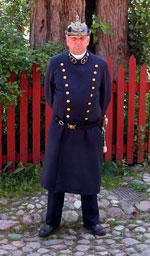
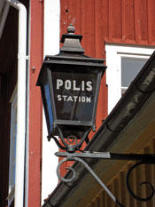
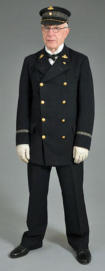
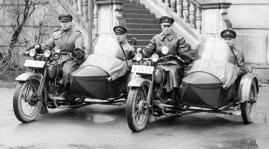
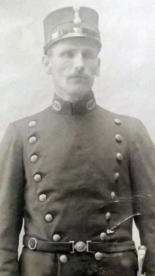
Corresponding Rural Police Titles in the UK and US


Sweden
UK
US
Fjärdingsman
Parish Constable
Deputy Sheriff
Länsman
Chief Constable
Sheriff
Kronofogde
County Police
Commissioner
Enforcement Officer

Source References
•
Polisen i Stockholm förr och nu av Bengt Järbe,
1975.
•
Polisväsendet i Stockholm 1776 - 1850 av Nils Staf,
1950.
•
Din Polis, En orientering om polisväsendet på
landsbygden, utgiven av Malmöhus polisförening
1955.
•
Polisväsendet på landsbygden, Lundgrens förlag
Jönköping 1911.
•
Wikipedia
Top of page



















